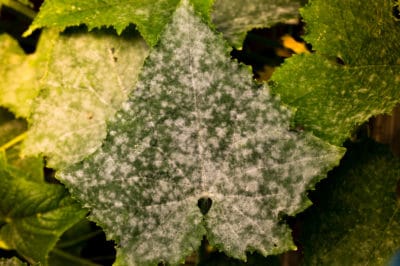Symptoms
Cuke plants stricken with powdery mildew exhibit these symptoms:
- White, powdery spots slowly spread across the tops a vine’s lower, shaded leaves.
- The spots spread to the leaves’ undersides.
- On the tops of the leaves, yellow spots surface amidst the white ones.
- The fungus may colonize the leaf stalks (petioles) and stems.
- Eventually, the infected leaves and plant tissues shrivel up and die.
Mildew-Favoring Conditions
Powdery mildew fungi love days and nights with temperatures in the 68 to 81°F (20-27.2°C) range. What they don’t like are bright, sunny days that raise leaf surface temperatures above 95°F (35°C). That’s because their spores can’t survive exposure to sun or high temperatures. They get around that problem by attacking your cukes’ shaded lower leaves.
Treating Powdery Mildew
As soon as the first white spots appear on your cukes, snip off the affected leaves and dispose of them in sealed plastic bags. Then mix 1 tablespoon (14.8 ml) of baking soda in 1 gallon (3.8 liters) of water, pour it into a good-quality garden sprayer and coat all your plants until the solution drips from both sides of their leaves.
Expert gardener’s tips:
- Powdery mildew spores need an acid environment. The alkaline baking soda solution neutralizes the leaves’ natural acidity.
- When removing the diseased leaves from your cukes, be sure to sterilize your pruning tools in rubbing alcohol between cuts so they don’t spread the spores.
Preventing Powdery Mildew
Because this can spread with lightning speed, prevention is always preferable to treatment. Prevention is as simple as planting the right cukes in the right place.
Mildew-resistant Cukes
The simplest way to make sure powdery mildew never finds your cucumber patch is to stick with mildew-resistant cultivars. Popular choices include:
- ‘Cool Breeze,’ prized as a source of sweet pickles. Each self-pollinating plant is capable of producing up to 50 four-inch cucumbers.
- ‘Marketmore 76,’ a favorite among home gardeners. It yields 6- to 8-inch slicing cukes on 3- to four-foot vines in just 63 days.
- ‘Salad Bush Hybrid,’ with 8-inch slicing cukes on 26-inch vines. It’s the ideal for containers or small-space gardens.
Give your cukes six or more hours of daily sun, trellis them and thin their foliage regularly to reduce the amount of shade it throws. As soon as conditions favor a mildew outbreak, dowse them with the baking soda solution and repeat twice weekly until they subside.
